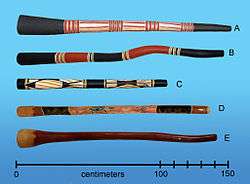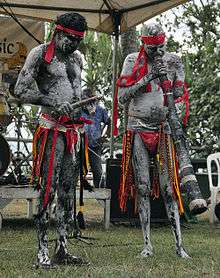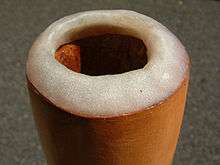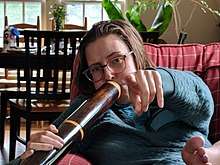Didgeridoo
The didgeridoo (/ˌdɪdʒəriˈduː/; also spelt didjeridu, among other variants) is a wind instrument. The didgeridoo was developed by Aboriginal peoples of northern Australia at least 1,500 years ago, and is now in use around the world, though still most strongly associated with Indigenous Australian music. The Yolŋu name for the instrument is the yiḏaki, or more recently by some, mandapul; in the Bininj Kunwok language of West Arnhem Land it is known as mako.[1]
 A, B and C: traditionally made didgeridoos. D and E: non-traditional didgeridoos. | |
| Other names | Didjeridu, yiḏaki, mandapul, mago, etc. |
|---|---|
| Classification | |
| Hornbostel–Sachs classification | 423.121.11 (end-blown straight tubular natural trumpet without mouthpiece) |
| Playing range | |
| Written range: fundamental typically A2 to G3 | |

A didgeridoo is usually cylindrical or conical, and can measure anywhere from 1 to 3 m (3 to 10 ft) long. Most are around 1.2 m (4 ft) long. Generally, the longer the instrument, the lower its pitch or key. However, flared instruments play a higher pitch than unflared instruments of the same length.
Origin
There are no reliable sources of the exact age of the didgeridoo. Archaeological studies suggest that people of the Kakadu region in Northern Australia have been using the didgeridoo for less than 1,000 years, based on the dating of rock art paintings.[2] A clear rock painting in Ginga Wardelirrhmeng, on the northern edge of the Arnhem Land plateau, from the freshwater period[3] (that had begun 1500 years ago)[4] shows a didgeridoo player and two songmen participating in an Ubarr ceremony.[5] It is thus thought that it was developed by Aboriginal peoples of northern Australia, possibly in Arnhem Land.
T. B. Wilson's Narrative of a Voyage Round the World (1835) includes a drawing of an Aboriginal man from Raffles Bay on the Cobourg Peninsula (about 350 kilometres (220 mi) east of Darwin) playing the instrument. Others observed such an instrument in the same area, made of bamboo and about 3 feet (0.91 m) long. In 1893, English palaeontologist Robert Etheridge, Junior observed the use of "three very curious trumpets" made of bamboo in northern Australia. There were then two native species of bamboo growing along the Adelaide River, Northern Territory".[6]
According to A. P. Elkin, in 1938, the instrument was "only known in eastern Kimberley [in Western Australia] and the northern third of the Northern Territory".[7]
Etymology
The name didgeridoo is not of Aboriginal Australian linguistic origin and is considered to be an onomatopoetic word. The earliest occurrences of the word in print include a 1908 edition of the Hamilton Spectator referring to a "'did-gery-do' (hollow bamboo)",[8] a 1914 edition of The Northern Territory Times and Gazette,[9] and a 1919 issue of Smith's Weekly, in which it was referred to as a "didjerry" and was said to produce the sound "didjerry, didjerry, didjerry and so on ad infinitum".[10]
A rival explanation, that didgeridoo is a corruption of the Irish Gaelic phrase dúdaire dubh or dúidire dúth, is controversial.[11] Dúdaire or dúidire is a noun that, depending on the context, may mean "trumpeter", "hummer", "crooner" or "puffer", while dubh means "black", and dúth means "native". The idea arose because a significant proportion of early European colonists in Australia were from Ireland. The hypothesis has sometimes been badly misunderstood and mis-repeated as a romanticized and ethnocentric belief in a Celtic origin of the instrument. The ancient Irish did use a long horn, the dord, and mainland-European Celtic people of the Iron Age used another such instrument called the carnyx, but there is no evidence they were not played in the trumpeting style of other European horns. Nevertheless, some modern players of reconstructed Celtic horns play them in a didgeridoo style.
Other names
There are numerous names for the instrument among the Aboriginal peoples of northern Australia, none of which closely resemble the word "didgeridoo" (see below). Some didgeridoo enthusiasts, scholars and Aboriginal people advocate using local language names for the instrument.[12]
Yiḏaki (transcribed yidaki in English, sometimes spelt yirdaki) is one of the most commonly used names although, strictly speaking, it refers to a specific type of the instrument made and used by the Yolngu peoples of north-east Arnhem Land.[13] Some Yolngu people began using the word mandapul after 2011, out of respect for the passing of a Manggalili man who had a name sounding similar to yidaki.[14]
In west Arnhem Land, it is known as a mako, a name popularised by virtuoso player David Blanasi, a Bininj man, whose language was Kunwinjku, and who brought the didgeridoo to world prominence.[7] However the mako is slightly different from the Yiḏaki: usually shorter, and sounding somewhat different – a slightly fuller and richer sound, but without the "overtone" note.[14][15][7]
There are at least 45 names for the didgeridoo, several of which suggest its original construction of bamboo, such as bambu, bombo, kambu, and pampu, which are still used in the lingua franca by some Aboriginal people. The following are some of the more common regional names.[6]
| People | Region | Local name |
|---|---|---|
| Anindilyakwa | Groote Eylandt | ngarrriralkpwina |
| Arrernte | Alice Springs | ilpirra |
| Djinang (a Yolngu people) | Arnhem Land | yiḏaki |
| Gagudju | Arnhem Land / Kakadu | garnbak |
| Gupapuygu | Arnhem Land | yiraka |
| Iwaidja | Cobourg Peninsula | artawirr |
| Jawoyn | Katherine / Nitmiluk / Kakadu | gunbarrk |
| Kunwinjku | Arnhem Land / Kakadu | mako[16] |
| Mayali | Alligator Rivers | martba |
| Ngarluma | Roebourne, W.A. | kurmur |
| Nyul Nyul | Kimberleys | ngaribi |
| Pintupi | Central Australia | paampu |
| Warray | Adelaide River | bambu |
| Yolngu | Arnhem Land | mandapul (yiḏaki) |
Description and construction
A didgeridoo is usually cylindrical or conical, and can measure anywhere from 1 to 3 m (3 to 10 ft) long. Most are around 1.2 m (4 ft) long. Generally, the longer the instrument, the lower its pitch or key. However, flared instruments play a higher pitch than unflared instruments of the same length.[17]
The didgeridoo is classified as a wind instrument and is similar in form to a straight trumpet, but made of wood. It has also been called a dronepipe.[18]
Traditional

Traditional didgeridoos are usually made from hardwoods, especially the various eucalyptus species that are endemic to northern and central Australia.[19] Generally the main trunk of the tree is harvested, though a substantial branch may be used instead. Traditional didgeridoo makers seek suitably hollow live trees in areas with obvious termite activity. Termites attack these living eucalyptus trees, removing only the dead heartwood of the tree, as the living sapwood contains a chemical that repels the insects.[20] Various techniques are employed to find trees with a suitable hollow, including knowledge of landscape and termite activity patterns, and a kind of tap or knock test, in which the bark of the tree is peeled back, and a fingernail or the blunt end of a tool, such as an axe, is knocked against the wood to determine if the hollow produces the right resonance.[21] Once a suitably hollow tree is found, it is cut down and cleaned out, the bark is taken off, the ends trimmed, and the exterior is shaped; this results in a finished instrument. A rim of beeswax may be applied to the mouthpiece end.
Modern
Non-traditional didgeridoos can be made from native or non-native hard woods (typically split, hollowed and rejoined), glass, fibreglass, metal, agave, clay, hemp (in the form of a bioplastic named zelfo), PVC piping and carbon fibre. These typically have an upper inside diameter of around 1.25" down to a bell end of anywhere between two and eight inches and have a length corresponding to the desired key. The end of the pipe can be shaped and smoothed to create a comfortable mouthpiece or an added mouthpiece can be made of any shaped and smoothed material such as rubber, rubber stopper with a hole or beeswax.
Modern didgeridoo designs are distinct from the traditional Australian Aboriginal didgeridoo, and are innovations recognised by musicologists.[22] Didgeridoo design innovation started in the late 20th century, using non-traditional materials and non-traditional shapes. The practice has sparked, however, a good deal of debate (aesthetic, ethic, and legal) among indigenous practitioners and non-indigenous people.[23][24]
Decoration
Didgeridoos can be painted by their maker or a dedicated artist using traditional or modern paints while others retain the natural wood grain design with minimal or no decoration.
Playing
.jpg)
The didgeridoo is played with continuously vibrating lips to produce the drone while using a special breathing technique called circular breathing. This requires breathing in through the nose whilst simultaneously expelling stored air out of the mouth using the tongue and cheeks. By use of this technique, a skilled player can replenish the air in their lungs, and with practice can sustain a note for as long as desired. Recordings exist of modern didgeridoo players playing continuously for more than 40 minutes; Mark Atkins on Didgeridoo Concerto (1994) plays for over 50 minutes continuously.
The didgeridoo functions "...as an aural kaleidoscope of timbres"[25] and that "the extremely difficult virtuoso techniques developed by expert performers find no parallel elsewhere."[25]
Physics and operation

A termite-bored didgeridoo has an irregular shape that, overall, usually increases in diameter towards the lower end. This shape means that its resonances occur at frequencies that are not harmonically spaced in frequency. This contrasts with the harmonic spacing of the resonances in a cylindrical plastic pipe, whose resonant frequencies fall in the ratio 1:3:5 etc. The second resonance of a didgeridoo (the note sounded by overblowing) is usually around an 11th higher than the fundamental frequency (a frequency ratio of 8:3).
The vibration produced by the player's lips has harmonics, i.e., it has frequency components falling exactly in the ratio 1:2:3 etc. However, the non-harmonic spacing of the instrument's resonances means that the harmonics of the fundamental note are not systematically assisted by instrument resonances, as is usually the case for Western wind instruments (e.g., in the low range of the clarinet, the 1st, 3rd, and 5th harmonics of the reed are assisted by resonances of the bore).
Sufficiently strong resonances of the vocal tract can strongly influence the timbre of the instrument. At some frequencies, whose values depend on the position of the player's tongue, resonances of the vocal tract inhibit the oscillatory flow of air into the instrument. Bands of frequencies that are not thus inhibited produce formants in the output sound. These formants, and especially their variation during the inhalation and exhalation phases of circular breathing, give the instrument its readily recognizable sound.
Other variations in the didgeridoo's sound can be made by adding vocalizations to the drone. Most of the vocalizations are related to sounds emitted by Australian animals, such as the dingo or the kookaburra. To produce these sounds, the players simply have to use their vocal folds to produce the sounds of the animals whilst continuing to blow air through the instrument. The results range from very high-pitched sounds to much lower sounds involving interference between the lip and vocal fold vibrations. Adding vocalizations increases the complexity of the playing.
In popular culture
Modern performances using the didgeridoo include combining it with beatboxing. It was featured on the British children's TV series Blue Peter.[26]
The didgeridoo also became a role playing instrument in the experimental and avant-garde music scene. Industrial music] bands like Test Department generated sounds from this instrument and used them in their performances.
It is very often used in the music project Naakhum which combines Extreme Metal and Ethnic music.
Early songs by the acid jazz band Jamiroquai featured didgeridoo player Wallis Buchanan (until he left the band in 1999). A notable song featuring a didgeridoo is the band's first single "When You Gonna Learn", which features prominent didgeridoo playing in both the introduction and solo sections.
The instrument is commonly used by ambient artist Steve Roach as a complement to his produced soundscapes, in both live and recorded formats. It features prominently in his collaborative work Australia: Sound of the Earth (with Australian Aboriginal artist David Hudson and cellist Sarah Hopkins) as well as Dreamtime Return.
It is used in the Indian song "Jaane Kyon" from the film Dil Chahta Hai.
Chris Brooks, lead singer of the New Zealand hard rock band Like a Storm uses the didgeridoo in some of the band's songs including "Love the Way You Hate Me" from their album Chaos Theory: Part 1.
Kate Bush made extensive use of the didgeridoo (played by Australian musician Rolf Harris) on her album The Dreaming, which was written and recorded after a holiday in Australia.
Charlie McMahon, who formed the group Gondwanaland, was one of the first non-Aboriginal players to gain fame as a professional didgeridoo player. He has toured internationally with Midnight Oil. He invented the didjeribone, a sliding didgeridoo made from two lengths of plastic tubing; its playing style is somewhat in the manner of a trombone, hence the portmanteau name.
Cultural significance


Traditionally, the didgeridoo was played as an accompaniment to ceremonial dancing and singing and for solo or recreational purposes. For Aboriginal peoples of northern Australia, the yidaki is still used to accompany singers and dancers in cultural ceremonies. For the Yolngu people, the yidaki is part of their whole physical and cultural landscape and environment, comprising the people and spirit beings which belong to their country, kinship system and the Yolngu Matha language. It is connected to Yolngu Law and underpinned by ceremony, in song, dance, visual art and stories.[13]
Pair sticks, sometimes called clapsticks (bilma or bimla by some traditional groups)[27], establish the beat for the songs during ceremonies. The rhythm of the didgeridoo and the beat of the clapsticks are precise, and these patterns have been handed down for many generations. In the Wangga genre, the song-man starts with vocals and then introduces bilma to the accompaniment of didgeridoo.[28]
Gender-based traditional prohibition debate
Traditionally, only men play the didgeridoo and sing during ceremonial occasions and playing by females is sometimes discouraged by Aboriginal communities and elders. In 2008, publisher Harper Collins apologized for its book The Daring Book for Girls, which openly encouraged girls to play the instrument after some Aboriginal academics described such encouragement as "extreme cultural insensitivity" and "an extreme faux pas ... part of a general ignorance that mainstream Australia has about Aboriginal culture."[2][29][30] However, Linda Barwick, an ethnomusicologist, says that though traditionally women have not played the didgeridoo in ceremony, in informal situations there is no prohibition in the Dreaming Law.[31] For example, Jemima Wimalu, a Mara woman from the Roper River is very proficient at playing the didgeridoo and is featured on the record Aboriginal Sound Instruments released in 1978. In 1995, musicologist Steve Knopoff observed Yirrkala women performing djatpangarri songs that are traditionally performed by men and in 1996, ethnomusicologist Elizabeth MacKinley reported women of the Yanyuwa group giving public performances.
While there is no prohibition in the area of the didgeridoo's origin, such restrictions have been applied by other Indigenous communities. The didgeridoo was introduced to the Kimberleys almost a century ago but it is only in the last decade that Aboriginal men have shown adverse reactions to women playing the instrument and prohibitions are especially evident in the South East of Australia. The belief that women are prohibited from playing is widespread among non-Aboriginal people and is also common among Aboriginal communities in Southern Australia; some ethnomusicologists believe that the dissemination of the taboo belief and other misconceptions is a result of commercial agendas and marketing. The majority of commercial didgeridoo recordings available are distributed by multinational recording companies and feature non-Aboriginal people playing a New Age style of music with liner notes promoting the instrument's spirituality which misleads consumers about the didgeridoo's secular role in traditional Aboriginal culture.[2]
The taboo is particularly strong among many Aboriginal groups in the South East of Australia, where it is forbidden and considered "cultural theft" for non-Aboriginal women, and especially performers of New Age music regardless of gender, to play or even touch a didgeridoo.[2]
Health benefits
A 2005 study reported in the British Medical Journal found that learning and practising the didgeridoo helped reduce snoring and obstructive sleep apnea by strengthening muscles in the upper airway, thus reducing their tendency to collapse during sleep. In the study, intervention subjects were trained in and practiced didgeridoo playing, including circular breathing and other techniques. Control subjects were asked not to play the instrument. Subjects were surveyed before and after the study period to assess the effects of intervention.[32] A small 2010 study noted improvements in the asthma management of Aboriginal teens when incorporating didgeridoo playing.[33]

See also
- Aboriginal Centre for the Performing Arts
- Alphorn
- Djalu Gurruwiwi, master maker and player of yiḏaki
- Erke
- List of didgeridoo players
- Mayan trumpet
Selected bibliography
- Ah Chee Ngala, P., Cowell C. (1996): How to Play the Didgeridoo – and history. ISBN 0-646-32840-9
- Chaloupka, G. (1993): Journey in Time. Reed, Sydney.
- Cope, Jonathan (2000): How to Play the Didgeridoo: a practical guide for everyone. ISBN 0-9539811-0-X.
- Jones, T. A. (1967): "The didjeridu. Some comparisons of its typology and musical functions with similar instruments throughout the world". Studies in Music 1, pp. 23–55.
- Kaye, Peter (1987): How to Play the Didjeridu of the Australian Aboriginal – A Newcomer's Guide.
- Kennedy, K. (1933): "Instruments of music used by the Australian Aborigines". Mankind (August edition), pp. 147–157.
- Lindner, D. (ed) (2005): The Didgeridoo Phenomenon. From Ancient Times to the Modern Age. Traumzeit-Verlag, Germany.
- Moyle, A. M. (1981): "The Australian didjeridu: A late musical intrusion". in World Archaeology, 12(3), 321–31.
- Neuenfeldt, K. (ed) (1997): The didjeridu: From Arnhem Land to Internet. Sydney: J. Libbey/Perfect Beat Publications.
References
- Garde, Murray. "Bininj Kunwok Online Dictionary". njamed.com. Bininj Kunwok Regional Language Centre. Retrieved 12 August 2020.
- Neuenfeldt, Karl, ed. (1997). The Didjeridu: From Arnhemland to Internet. Perfect Beat Publishers. pp. 89–98. ISBN 1-86462-003-X.
- "Kakadu National Park – Rock art styles". Archived from the original on 21 April 2012. Retrieved 21 April 2012.
- Sayers, Andrew (2001) [2001]. Australian Art (Oxford History of Art) (paperback). Oxford History of Art. Oxford University Press, USA (published 19 July 2001). p. 19. ISBN 978-0192842145.
- George Chaloupka, Journey in Time, p. 189.
- "The Didgeridoo and Aboriginal Culture". Aboriginal Australia Art & Culture Centre, Alice Springs, Australia. 2020. Retrieved 21 January 2020.
- "History of the Didgeridoo Yidaki". Aboriginal Arts. Retrieved 21 January 2020.
- "Retribution". Hamilton Spectator (7567). Victoria, Australia. 24 October 1908. p. 8. Retrieved 28 January 2017 – via National Library of Australia.
- "Correspondence". The Northern Territory Times and Gazette. XXXVIII (2145). Northern Territory, Australia. 17 December 1914. p. 14. Retrieved 28 January 2017 – via National Library of Australia.
- "Meanings and origins of Australian words and idioms: D". Australian National Dictionary Centre. Retrieved 27 January 2017.
- "It's as Irish as – er – didgeridoo". Flinders Journal. Flinders University. 10–23 June 2002. Archived from the original on 19 August 2002. Retrieved 30 October 2012.
- "Are "Didjeridu" and "Yidaki" the same thing?". Yidaki Dhawu Miwatjnurunydja. Buku Larrngay Mulka Centre. Archived from the original on 14 February 2011. Retrieved 14 July 2011.
- Nicholls, Christine Judith (6 April 2017). "Friday essay: the remarkable yidaki (and no, it's not a 'didge')". The Conversation. Retrieved 19 January 2020.
- "Yidaki". Spirit Gallery. Retrieved 19 January 2020.
- "Didgeridoo terminology: 5- What is the horn, toot, overtone note?". Spirit Gallery. Retrieved 19 January 2020.
- Garde, Murray. "Bininj Kunwok Online Dictionary". njamed.com. Bininj Kunwok Regional Language Centre. Retrieved 28 May 2019.
- Fletcher, N.H. (1996) The didjeridu (didgeridoo). Acoustics Australia 24, 11-15.
- "Didjeridu: Musical instrument". Encyclopedia Britannica. Retrieved 19 January 2020.
- Taylor R., Cloake J, and Forner J. (2002) Harvesting rates of a Yolgnu harvester and comparison of selection of didjeridu by the Yolngu and Jawoyn, Harvesting of didjeridu by Aboriginal people and their participation in the industry in the Northern Territory (ed. R. Taylor) pp. 25–31. Report to AFFA Australia. Northern Territory Parks and Wildlife Service, Department of Infrastructure, Planning and Environment, Palmerston, NT.
- McMahon, Charlie. (2004) The Ecology of Termites and Didjeridus, The Didgeridoo: From Ancient Times to the Modern Age (ed. David Lindner) Schönau: Traumzeit-Verlag
- "How is a Yidaki Made?". Yidaki Dhawu Miwatjnurunydja. Buku Larrngay Mulka Centre. Archived from the original on 14 February 2011. Retrieved 14 July 2011.
- Wade-Matthews, M., Thompson, W., The Encyclopedia of Music, 2011, pp184–185. ISBN 0-7607-6243-0
- Brian Fitzgerald and Susan Hedge, "Traditional Cultural Expression and the Internet World," in Christoph Antons, ed., Traditional Knowledge, Traditional Cultural Expressions, and Intellectual Property Law in the Asia-Pacific Region (Aalphen an den Rijn, Netherlands: 2009), 264-65. ISBN 9789041127211
- Hannah Edgar and Elias Gross, "Earth Sounds: The Didgeridoo Stirs Controversy at the Bang on a Can Summer Festival" (8/8/2019). Available at https://www.newsounds.org/story/earth-sounds-didgeridoo-stirs-controversy-bang-can-summer-festival/
- A Baines, The Oxford Companion to Musical Instruments OUP 1992
- "Didgeridoo Beat-boxing". Blue Peter. BBC. Retrieved 31 July 2013.
- "Clapsticks: Teaching with Unique Objects". University of Melbourne: Teaching with Unique Collections. Retrieved 24 July 2019.
- Elkin, A. P. (1979) [1938]. The Australian Aborigines. Angus & Robertson. Sydney, NSW. p. 290. ISBN 0-207-13863-X. Quoted at Manikay.Com. Retrieved 17 April 2011.
- Didgeridoo book upsets Aborigines, BBC
- 'Daring Book for Girls' breaks didgeridoo taboo in Australia
- "Women can play didgeridoo – taboo incites sales". Archived from the original on 4 June 2007. Retrieved 25 May 2007.
- Puhan MA, Suarez A, Lo Cascio C, et al. (2005). "Didgeridoo playing as alternative treatment for obstructive sleep apnea syndrome: randomised controlled trial". BMJ. 332 (7536): 266–70. doi:10.1136/bmj.38705.470590.55. PMC 1360393. PMID 16377643.
- Eley, Robert; Gorman, Don (2010). "Didgeridoo Playing and Singing to Support Asthma Management in Aboriginal Australians" (PDF). The Journal of Rural Health. 26 (1): 100–104. doi:10.1111/j.1748-0361.2009.00256.x. ISSN 0890-765X. PMID 20105276.
External links
| Wikimedia Commons has media related to: |
- iDIDJ Australian Didgeridoo Cultural Hub
- The Didjeridu W3 Server
- The physics of the didj
- Didgeridoo acoustics from the University of New South Wales
- Database of audio recordings of traditional Arnhem Land music, samples included, many with didgeridoo
- The Didjeridu: A Guide By Joe Cheal – General info on the didgeridoo, with citations and references
- BioloDidje (translations available)
- Yidakiwuy Dhawu Miwatjngurunydja comprehensive site by traditional owners of the instrument
